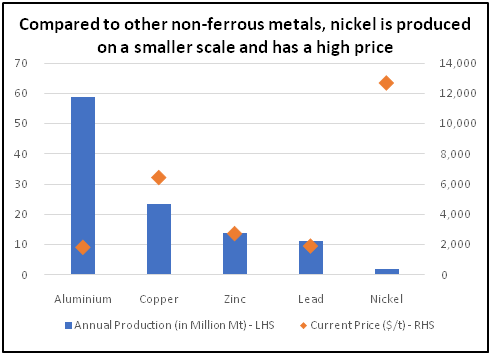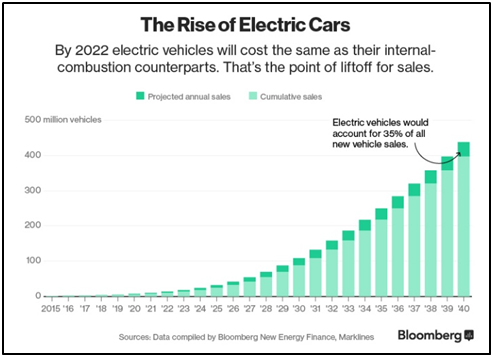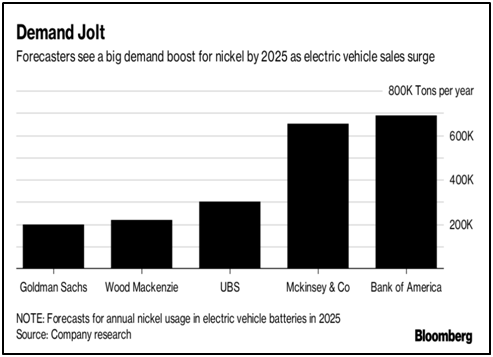
 The last metal that we will be talking about is nickel, a silvery-white metal that is hard, ductile, corrosion-resistant, has a high-melting point, and is ferromagnetic at room temperature. Because of nickel’s versatile properties, it is widely used with other non-ferrous and ferrous metals to make alloys. Besides being used to make alloys, nickel has other widespread applications too, which will be discussed in the next section.
The last metal that we will be talking about is nickel, a silvery-white metal that is hard, ductile, corrosion-resistant, has a high-melting point, and is ferromagnetic at room temperature. Because of nickel’s versatile properties, it is widely used with other non-ferrous and ferrous metals to make alloys. Besides being used to make alloys, nickel has other widespread applications too, which will be discussed in the next section.
 As compared to other non-ferrous metals that we have discussed earlier, nickel is produced in smaller quantities and has the highest price (per metric tonne of the metal). Nickel is found extensively in the earth’s crust and core. In fact, nickel is the fifth most abundant element on our planet. Indonesia, Philippines, Russia, and Canada are the largest producing countries of nickel, accounting for over halfof the global output.
As compared to other non-ferrous metals that we have discussed earlier, nickel is produced in smaller quantities and has the highest price (per metric tonne of the metal). Nickel is found extensively in the earth’s crust and core. In fact, nickel is the fifth most abundant element on our planet. Indonesia, Philippines, Russia, and Canada are the largest producing countries of nickel, accounting for over halfof the global output.
Nickel derivatives are traded around the world. LME and SHFE are two of the major exchanges that offer trading in nickel. In India, nickel futures is traded on the MCX platform.
Nickel usage
 Because of nickel’s versatile properties, it has a wide range of applications. Around 2 million tonnes of nickel are produced each year. Of this, more than two-thirds go towards producing stainless steel. Nickel is used as an alloying agent in stainless steel in order to increase its strength at low and high temperatures, toughness, and resistance to corrosion. The addition of nickel into stainless steel makes the latter an extremely versatile alloy. As an end product, stainless steel has a range of consumer and industrial applications. On the consumer side, stainless steel is commonly used in cutlery and kitchenware. On the industrial side, stainless steel is widely used in chemical and oil & gas industries, in power generation industries, in building and construction, and in the automotive sector. The most common grades of stainless steel that contain nickel are type 304 (which contains 8% nickel) and type 316 (which contains 11% nickel).
Because of nickel’s versatile properties, it has a wide range of applications. Around 2 million tonnes of nickel are produced each year. Of this, more than two-thirds go towards producing stainless steel. Nickel is used as an alloying agent in stainless steel in order to increase its strength at low and high temperatures, toughness, and resistance to corrosion. The addition of nickel into stainless steel makes the latter an extremely versatile alloy. As an end product, stainless steel has a range of consumer and industrial applications. On the consumer side, stainless steel is commonly used in cutlery and kitchenware. On the industrial side, stainless steel is widely used in chemical and oil & gas industries, in power generation industries, in building and construction, and in the automotive sector. The most common grades of stainless steel that contain nickel are type 304 (which contains 8% nickel) and type 316 (which contains 11% nickel).
Besides being used as an alloy in making stainless steel, nickel is used as an alloying agent with other non-ferrous metals too. Around 15% of nickel’s use comes from it being combined with various non-ferrous and precious metals such as copper, aluminium, lead, silver, gold etc. Again, the reason for using nickel as an alloying agent with other non-ferrous metals is to enhance the properties of the alloy such as increasing the resistance to corrosion, ability to withstand extreme temperatures, etc.
Around 8% of nickel’s usage comes from electroplating, i.e. applying a thin layer of nickel over a metal or metal alloy. The objective of electroplating with nickel could be for decorative or functional purposes. Manufactured products such as consumer goods are sometimes electroplated with nickel in order to enhance their looks and appeal. Examples include the automotive industry (where nickel is sometimes electroplated on the exhaust pipe, bumpers etc.) and household applications (where nickel is sometimes electroplated on lighting and plumbing fixtures). Nickel electroplating is also done to enhance the physical properties of the surface of the metal being electroplated. This includes improving the durability and performance of the metal as well as enhancing the anti-corrosion property of the metal. On occasions, nickel electroplating is done to achieve the dual objective of enhancing the looks and improving the physical properties of the metal being electroplated.
Other uses of nickel include its application in batteries (around 3% of demand) and chemicals, catalysts & dyes (around 2% of demand). Nickel is widely used in making rechargeable batteries that have a range of applications. Furthermore, nickel is a key component of Lithium-ion batteries, which are batteries that power most of the electric vehicles (EVs) today. The reason why nickel is a key component of Lithium-ion batteries is because it offershigher energy density and storage capacity at a lower cost. Lastly, nickel is also used to make chemical compounds such as nickel sulphate, nickel chloride, nickel nitrate, nickel oxide, etc. These compounds have various uses including those in automotive, aircrafts, electronics, and batteries.
Factors that impact the price of nickel
Nickel has a wide range of applications and hence its price is influenced by a variety of factors. Some of the factors that impact other non-ferrous metals also impact the price of nickel. These include the dollar (nickel has a negative correlation with dollar), central bank monetary policies (accommodative monetary policies benefit nickel, and vice versa), warehouse inventories (lower inventories indicate a tight market and is price supportive, and vice versa). As we have already covered these factors in some of the earlier chapters, we won’t be covering them again. Besides these, other major factors that impact the price of nickel are as mentioned below:
Demand from China
China is the world’s largest consumer of nickel, accountingfor half of the global output each year. More than 80% of Chinese demand for nickel goes into making stainless steel, while the rest goes into electroplating and other applications. Given that a bulk of nickel goes into making stainless steel, demand for nickel from China is heavily impacted by China’s demand for stainless steel. Higher the demand for stainless steel, higher the demand for nickel, and vice versa.
Stainless steel is used in a wide range of applications such as in architecture & construction, in automotive & transportation sector, in energy & heavy industries, and in consumer products such as cutlery & kitchenware. As such, demand for stainless steel in China depends heavily on the economic health of the nation as well as on the prevailing consumer sentiment. A stronger and growing Chinese economy would bolster consumer sentiment and thereby boost spending. This in turn would translate into higher demand for stainless steel and subsequently higher demand for nickel. The converse is also true in case of a weakening Chinese economy and deteriorating consumer sentiment.
Demand from other key nations
While China is arguably the most important factor drivingthe demand for nickel, the health of the global economyalso plays an important role. Given how widely nickel is used in stainless steel production and given the applications of stainless steel, demand for nickel is also heavily influenced by the health of global manufacturing activity, architecture & construction sector, automotive & transportation sector, and demand for household products. Generally, the stronger the world economy, the stronger the demand for nickel, and vice versa.
Because of the superior properties that stainless steel possesses, its importance in the infrastructure, construction, and other sectors will only keep increasing in future. This is especially true in case of developing nations such as China and India, where the per capita income as well as the urbanization rate is quite low as compared to those of the developed nations. As the per capita income and urbanization rate in these economies grow, so would the need to develop infrastructure and construction facilities. All these would bolster the demand for stainless steel, which in turn would translate into a higher demand for nickel.
Future of the EV segment
 One key area that has a strong potential to become an important part of the broader nickel demand in the next several years is the revolution that is currently happening in the Electric Vehicles (EV) segment. Unlike traditional vehicles (ICEs) which are powered by lead-acid batteries, most of the EVs are powered by Lithium-ion batteries. Nickel is a key component of Lithium-ion batteries, wherein it is used in cathode. Two of the widely used Lithium-ion batteries with a cathode that comprises of nickel are:
One key area that has a strong potential to become an important part of the broader nickel demand in the next several years is the revolution that is currently happening in the Electric Vehicles (EV) segment. Unlike traditional vehicles (ICEs) which are powered by lead-acid batteries, most of the EVs are powered by Lithium-ion batteries. Nickel is a key component of Lithium-ion batteries, wherein it is used in cathode. Two of the widely used Lithium-ion batteries with a cathode that comprises of nickel are:
-
Nickel Cobalt Aluminium (NCA) batteries, which contain 80% nickel
-
Nickel Manganese Cobalt (NMC) batteries, which contain 33% nickel
 In fact, reports suggest that the nickel content in NMC batteries would increase to 80% by 2020. As stated earlier, the reason why nickel is used in Lithium-ion batteries is because it offers higher energy density and storage capacity at a lower cost. As Lithium-ion batteries become more and more affordable and as the world moves towards greener sources of energy, demand for EVs is only expected to head northwards in the next several years.
In fact, reports suggest that the nickel content in NMC batteries would increase to 80% by 2020. As stated earlier, the reason why nickel is used in Lithium-ion batteries is because it offers higher energy density and storage capacity at a lower cost. As Lithium-ion batteries become more and more affordable and as the world moves towards greener sources of energy, demand for EVs is only expected to head northwards in the next several years.
At present, EVs account for less than 3% of total vehicle sales worldwide. As per a report by Bloomberg New Energy Finance (BNEF), EVs worldwide would constitute over a third of vehicles on road by 2040. If these estimates pan out as expected, one can only imagine how strong demand for nickel will be in the next several years. As such, how the EV story unfolds will have a strong bearing on the demand and price trajectory of nickel in the coming decades.
How to trade nickel
When trading nickel, some of the key things to keep a track of are as mentioned below:
-
Monitor LME data regularly in order to identify trends in inventories and to know if they are at an extreme or are reversing.
-
Keep a track of the health of the stainless-steel sector, considering that 70% of nickel’s demand goes into making stainless steel.
-
Monitor economic data from China to gauge the health of its broader economy.
-
Keep a track of the pace of developments in the EV segment. As nickel is a key component of Lithium-ion batteries that are used in EVs, an increase in the usage of EVs in the future would boost demand for nickel from this sector.
-
Monitor the monetary and fiscal policy, primarily of China, to understand whether economic conditions are accommodative or tightening.
-
Keep a track on movements in global equities and other commodities to understand the prevailing sentiment in the market.
-
Keep a watch on the medium-term and long-term trend of the dollar, given the negative correlation between the two.
-
Compare LME inventories with LME price spreads, as this gives clues as to the prevailing tightness of nickel in the physical markets.
Next Chapter
Comments & Discussions in
FYERS Community